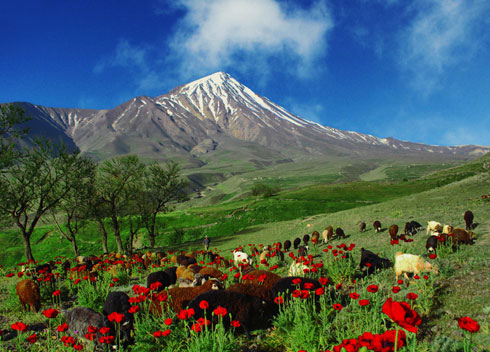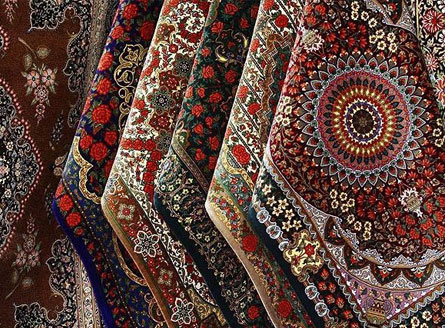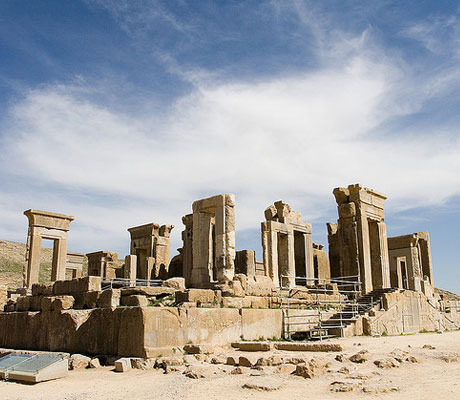Iran
Country statistics

Land area: 631,659 sq miles (1,635,999 sq km)
Total area: 636,293 sq miles (1,648,000 sq km)
Population (2010 est.): 67,037,517 (growth rate: 0.9%); birth rate: 17.3/1000; infant mortality rate: 34.6/1000; life expectancy: 71.4; density per sq km: 40
Capital City: Tehran
Monetary unit: Rial
Languages: Persian and Persian dialects 58%, Turkic and Turkic dialects 26%, Kurdish 9%, Luri 2%, Balochi 1%, Arabic 1%, Turkish 1%, other 2%
Ethnicity/race: Persian 51%, Azerbaijani 24%, Gilaki and Mazandarani 8%, Kurd 7%, Arab 3%, Lur 2%, Baloch 2%, Turkmen 2%, other 1%
Religions: Islam 98% (Shi'a 89%, Sunni 9%); Zoroastrian, Jewish, Christian, and Baha'i 2%
Country introduction

Iran is located in West Asia, in the Middle East, bordered by Turkmenistan on the north, Afghanistan and Pakistan on the east, Iraq and Turkey on the west and the Persian Gulf and the Gulf of Oman lie south of Iran, and the Caspian Sea.
Iran's most important mountains are the Zagros. The main mountain chain runs about 1,448 km (900 miles) from Lake Urmia to the Straits of Hormuz at the entrance of the Persian Gulf. The highest peaks of Zagros are Mount Dena at 4,409 m (14,465 ft) and Zard-Kuh at 4,200 m (13,780 ft). Rimming the Caspian Sea coast is another chain of mountains, the narrow but high Alborz Mountains. Located in the center of the Alborz Range is the volcanic Mount Damāvand at 5,610 m (18,406 ft), which is not only the country's highest peak but also the highest mountain on the Eurasian landmass west of the Hindu Kush. Iran's population is concentrated in its mountains and not in its lowlands, as with other countries. That's because its lowlands, with the exception of the south-west and the south-east (regions populated by non-Persians), are uninhabitable. Even its biggest city, Tehran, is in the foothills of towering mountains.
The vast deserts of Iran stretch across the plateau from the north-west, close to Tehran and Qom, for a distance of about 643 km (400 miles) to the south-east and beyond the frontier. Approximately one-sixth of the total area of Iran is barren desert. The two largest desert areas are known as the Kavir-e-Lut and the Dasht-e-Kavir. Third in size of these deserts is the Jazmurian. It is often said that the Kavir-e-Lut and Dasht-e-Kavir are impossible to cross except by the single road which runs from Yazd to Ferdows, but in recent years, heavy trucks and other vehicles have travelled over long stretches of these deserts.
Iran has about 1,287 km (800 miles) of coastline, roughly half along the eastern shore of the Persian Gulf, the rest along the Gulf of Oman. Its most important port, Bandar Abbas, is located on the Strait of Hormuz. The Caspian coastline in the north that stretches for 740 km (459 miles) is one of the most popular destinations for Iran's domestic tourists. Sandy beaches give way to wide open steppes, thickly forested foothills and eventually the bare peaks of the Alborz mountain range.
There are no major rivers in the country. Of the small rivers and streams, the only one that is navigable is the 830 km (520 miles) long Karun, which shallow-draft boats can negotiate from Khorramshahr to Ahvaz, a distance of about 180 km (110 miles). Other major rivers include the Karkheh, spanning 700 km (430 miles) and joining the Tigris; and the Zayandeh River, which is 300 km (190 miles) long. Several other permanent rivers and streams also drain into the Persian Gulf, while a number of small rivers that originate in the north-western Zagros or Alborz drain into the Caspian Sea. On the Central Plateau, numerous rivers form from snow melting in the mountains during the spring and flow through permanent channels, draining eventually into salt lakes that also tend to dry up during the summer months. There is a permanent salt lake, Lake Urmia in the north-west, whose brine content is too high to support fish or most other forms of aquatic life.
The culture

The name 'Iran' means 'land of the Aryans', and not to be confused with Arabs or Turks, Iranians are an Aryan race. 'Persia' is the name given to the more than 5,000 year old culture of Iran by the ancient Greeks, and 'Iran' became the official name of the country in 1932. Both names 'Persia' and 'Iran' are for the most part interchangeable, as are the names 'America' and 'the United Sates'.
Being one of the oldest continuously inhabited civilisations in the world, modern-day Iranian culture is enriched by centuries of tradition. Years of trade, conquest and invasion have created a distinct culture with myriad influences from far and wide, resulting in an overriding national identity and culture rich in symbolism. Religion plays an important part in many aspects of Iranian society, the legal and educational systems, dress, marriage, architecture, the arts and the media are all affected. As Iran is an Islamic nation, visitors can expect to see the hallmarks of Islam throughout Iran, which include mosques, the call to prayer, strict dress codes and the observance of Ramadan are the most easily noticed, although there is a complex network of rules, customs and traditions at play every day.
Although Iran's population is largely youthful and urban-centric, rich Persian artistic traditions are alive in contemporary Iran, with much of the elaborate architecture, cuisine, handicrafts and popular poetry of Iran having their origins in ancient Persia. In Iran, Persian Rugs have always been a vital part of the Persian culture. Iranians were some of the first people in history to weave carpets. First deriving from the notion of basic need, the Persian rug started out as a simple/pure weave of fabric that helped nomadic people living in ancient Iran stay warm from the cold, damp ground. As time progressed, the complexity and beauty of rugs increased to a point where rugs are now bought as decorative pieces. Because of the long history of fine silk and wool rug weaving in Iran, Persian rugs are world-renowned as some of the most beautiful, intricately designed rugs available.
Cuisine in Iran is considered to be one of the most ancient forms of cuisine around the world. Bread is arguably the most important food in Iran, with a large variety of different bread, some of the most popular of which include: nan and hamir, which are baked in large clay ovens (also called "tenurs"). In Iranian cuisine, there are many dishes that are made from dairy products. One of the most popular of which includes yoghurt ("mast"), which has a specific fermentation process that is widely put to use amongst most Iranians. In addition, mast is used to make both soup and is vital in the production of oil. In addition to these dairy products, Iranian cuisine involves a lot of dishes cooked from rice. Iranians believe that rice grain contains the inscription "it is the god". By eating rice grains, Iranians feel as though they are getting closer to their creator. Some popular rice dishes include boiled rice with a variety of ingredients such as meats, vegetables, and seasonings ("plov") including dishes like chelo-horesh, shish kebab with rice, chelo-kebab, rice with lamb, meatballs with rice, and kofte (plain boiled rice). In addition, Iranian cuisine is famous for its sweets. One of the most famous of which includes "baklava" with almonds, cardamom, and egg yolks. Iranian sweets typically involve the use of honey, cinnamon, lime juice, and sprouted wheat grain. One very popular dessert drink in Iran, "sherbet sharbat-portagal", is made from a mixture of orange peel and orange juice boiled in thin sugar syrup and diluted with rose water. Just like the people of many Middle Eastern countries, the most preferred drink of the people of Iran is tea (without milk) or "kakhve-khana".
Attractions & landmarks

A significant proportion of Iran's monuments date back more than 2,000 years. Persepolis, for example, was founded in 518 BC and functioned as the capital of the Achaemenid Empire dominating the area at the time. The city was built into the foot of a mountain 643 km (400 miles) south of present-day capital Teheran and, although its treasures were carried away by Alexander the Great in 330, the surviving stone carvings and friezes ensure it remains a very impressive site. Parsargadae was another dynastic capital built around the same time. Surviving buildings here include the Mausoleum of Cyrus II, a fortified terrace and the remains of the royal palace.
Religious sites are also well-represented in Iran. Tchogha Zanbil is an ancient holy city founded in around 1250 BC. Three walls form concentric circles around a series of temples and other religious buildings dedicated to Sumerian gods. The Mosque at Esfahan dates from a much later time, the early 17th century, and is a Muslim holy place. The Royal Mosque was erected between 1612 and 1630 and is richly decorated inside with enamel mosaics. In the extreme northwest of the country, the Armenian Monasteries stand testimony to a long-standing Christian presence in the region. Originally founded in the 7th century, the monasteries remain a pilgrimage site for Armenian Christians today as the location of the Apostle St Thaddeus' grave.
Two of Iran's monuments owe their existence to ancient trade routes. Bam is a desert city that rose from the site of an oasis. It formed an important stopping point on many ancient trade routes. The period between the 7th and 11th centuries was the high point of Bam's prosperity, as merchants traded their goods and it became known for the production of both cotton and silk. A more recent trading environment, albeit still dating from the 13th century, survives at Tabriz in the east of the country. The bazaar complex was constructed using red bricks and includes spaces for commercial activities, education, religion and social gatherings.
Shushtar is the location of a very early and ingenious use of water to power mills and irrigate 40,000 hectares of farmland. Dating from the 5th century BC, the Shushtar hydraulic system draws water from the Karun River to the city of Shushtar via a series of underground tunnels. The Persian Garden is in fact nine gardens scattered across Iran. Each was designed in the Persian style with four distinct areas intended to represent the Zoroastrian elements of water, sky, earth and plants. Taken as a whole, the gardens represented Eden, a paradise on Earth. The largest garden, Bagh-e Abas Abad stands close to the shore of the Caspian Sea and covers 420 hectares, while the oldest of the gardens is part of the complex at Pasargadae.
The Caspian Sea, a massive lake situated 4 hours from Tehran and is accessible by road is worth visiting. Around the lake are the provinces of Gilan and Mazandaran. The area around the lake has lush forests and orchards. There is a variety of wildlife in the forests including bears and leopards.
For visitors looking for sun, sea and sand then Chabahar Beach is an ideal place for vacation located in south-eastern Iran. The coast is rocky and offers beautiful scenery. Some of the areas along this coastline are perfect for water sports, including skiing and canoeing. There are good diving spots in the area. The water also offers refreshing swimming to have a break from the heat. This is a good place to relax and enjoy the beautiful sunsets. Caves offer other areas to explore.